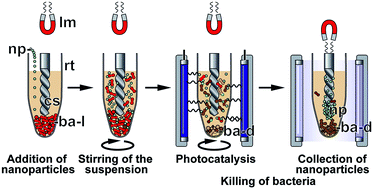A novel TiO2-assisted magnetic nanoparticle separator for treatment and inactivation of bacterial contaminants in aquatic systems
Abstract
Ferromagnetic nanoparticles (Fe-nanoparticles) have been functionalized with recombinant poly-Glu [glutamic acid]-tagged silicatein, a biomineral-synthesizing enzyme from siliceous sponges that forms the inorganic silica skeleton of those animals. The biocatalytic activity of silicatein was used to form a titania (TiO2) shell around the iron nanoparticle core, using the water-soluble non-natural substrate titanium bis(ammonium lactato)-dihydroxide (TiBALDH). Thereby the diameter of the nanoparticles increases from 7 nm to ≈22 nm. This procedure also allows the layer-by-layer fabrication of titania/silica–Fe-nanoparticles. SEM/EDX analysis confirmed the presence of the Ti and Si signals in the resulting titania–Fe-nanoparticles and titania/silica–iron nanoparticles, besides the dominant Fe signal. Utilizing the photocatalytic and ferromagnetic properties of the titania–Fe-nanoparticles a method has been developed for cleaning bacterial contaminants from aquatic systems. For that purpose, a novel magnetic nanoparticle separator has been constructed, with a motor-driven coil stirrer submersed into the reaction tube that contains, besides the bacteria, the titania–Fe-nanoparticles. This device enables the irradiation of contaminated water samples with UV light in order to initiate the photocatalytic reaction mediated by the titania–Fe-nanoparticles, resulting in the killing of the bacteria. At the end of the reaction, the iron nanoparticles can be recovered from the solution by applying an electromagnetic force, leaving behind the bacterial remains. This photocatalytic method and the magnetic nanoparticle separator allow a fast and efficient elimination of bacteria from aqueous solution and can be applied for remediation of aquatic environments.


 Please wait while we load your content...
Please wait while we load your content...